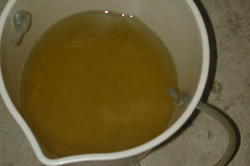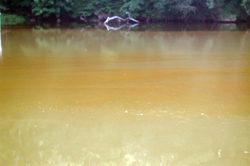|
|||||
The potentially ichthyotoxic (i.e., fish killing) dinoflagellate, Karlodinium micrum, has been replacing the late spring Mahogany Tide of Prorocentrum minimum in the lower Patuxent River. Samples collected by Maryland Department of Natural Resources (MD DNR) on June 21st from Jack Bay contained 4,293 Karlodinium cells/ml. A sample collected from Mackall Cove on St. Leonard Creek by Morgan State Estuarine Research Center (MS-ERC) on June 27th contained 105,000 Karlodinium cells/ml. Samples collected during the last week of June by Maryland Department of the Environment (MDE) and reviewed by MD DNR showed Karlodinium at low concentrations in the South River as well.
While this phytoplankton species has been associated with fish kills in Chesapeake Bay in the past, no evidence of fish kills was present at the site. The laboratory of Dr. Allen Place at the Center of Marine Biotechnology in Baltimore, MD, is testing the water samples for karlotoxin concentrations, a toxin sometimes produced by Karlodinium and shown to have fish killing ability. Water quality data collected by MD DNR’s continuous monitoring station at Pin Oak Farm show increasing levels of chlorophyll (an indicator of the amount of algae active in the water) and corresponding declines in dissolved oxygen. This type of combined behavior in chlorophyll and dissolved oxygen are often characteristic of algal bloom activity. The NOAA Coastwatch program is testing a Harmful Algal Bloom prediction tool and posting provisional weekly NOWCASTS of likely bloom activity for Karlodinium in Chesapeake Bay during the experimental phase of the work. MD DNR is working cooperatively with the Coastwatch Program and scientists at the University of Maryland Horn Point Laboratory, University of North Carolina-Charlotte and the Chesapeake Research Consortium to assess and improve the accuracy of these predictions. Visit https://coastwatch.noaa.gov/cbay_hab/ for the latest map of Karlodinium bloom predictions in Chesapeake Bay. DNR will continue to monitor this bloom. For up to date information on all of Maryland's harmful algal blooms and water quality monitoring results, please visit Eyes on the Bay |
|||||


